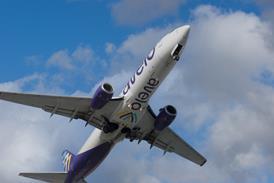GKN WESTLAND Aerospace has completed simulator tests of a so-called "neurofuzzy" computer program designed to enable helicopter pilots to avoid obstacles in poor visibility.
A neurofuzzy controller, developed by scientists at Southampton University in the UK, processes data from a range of sources to determine where it is safe for the aircraft to fly. The pilot is presented with a display of the safe flight-envelope around the aircraft's position.
Data sources include the aircraft's microwave- and millimetre-wave radars and airspeed, altitude, global-positioning-system and digital terrain-database readings. Each of the sources is "weighted" according to the reliability of the information supplied.
The way in which the data are processed - combining the "knowledge" of "fuzzy logic" with the learning ability of neural networks - means that the computer can attempt to predict the future position of the aircraft while taking into account the location of obstacles. The project, which is called the Helios, is partially sponsored by the UK Department of Trade and Industry under its Civil Aircraft Research and Demonstration programme.
Source: Flight International


























